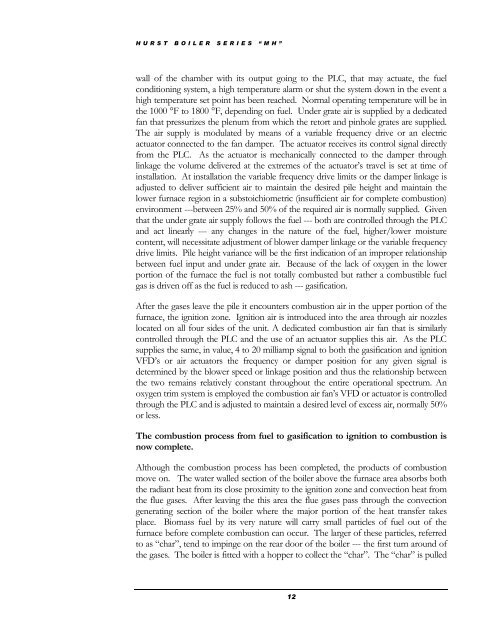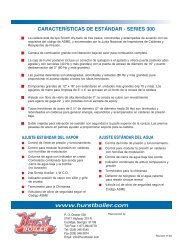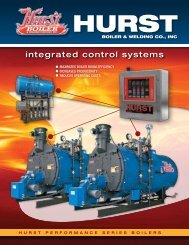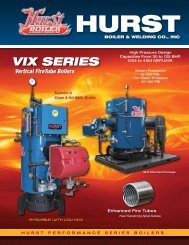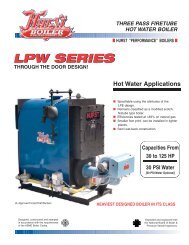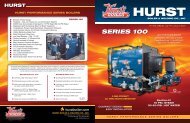Component & System Guide - Hurst Boiler
Component & System Guide - Hurst Boiler
Component & System Guide - Hurst Boiler
Create successful ePaper yourself
Turn your PDF publications into a flip-book with our unique Google optimized e-Paper software.
H U R S T B O I L E R S E R I E S “ M H ”<br />
wall of the chamber with its output going to the PLC, that may actuate, the fuel<br />
conditioning system, a high temperature alarm or shut the system down in the event a<br />
high temperature set point has been reached. Normal operating temperature will be in<br />
the 1000 °F to 1800 °F, depending on fuel. Under grate air is supplied by a dedicated<br />
fan that pressurizes the plenum from which the retort and pinhole grates are supplied.<br />
The air supply is modulated by means of a variable frequency drive or an electric<br />
actuator connected to the fan damper. The actuator receives its control signal directly<br />
from the PLC. As the actuator is mechanically connected to the damper through<br />
linkage the volume delivered at the extremes of the actuator’s travel is set at time of<br />
installation. At installation the variable frequency drive limits or the damper linkage is<br />
adjusted to deliver sufficient air to maintain the desired pile height and maintain the<br />
lower furnace region in a substoichiometric (insufficient air for complete combustion)<br />
environment ---between 25% and 50% of the required air is normally supplied. Given<br />
that the under grate air supply follows the fuel --- both are controlled through the PLC<br />
and act linearly --- any changes in the nature of the fuel, higher/lower moisture<br />
content, will necessitate adjustment of blower damper linkage or the variable frequency<br />
drive limits. Pile height variance will be the first indication of an improper relationship<br />
between fuel input and under grate air. Because of the lack of oxygen in the lower<br />
portion of the furnace the fuel is not totally combusted but rather a combustible fuel<br />
gas is driven off as the fuel is reduced to ash --- gasification.<br />
After the gases leave the pile it encounters combustion air in the upper portion of the<br />
furnace, the ignition zone. Ignition air is introduced into the area through air nozzles<br />
located on all four sides of the unit. A dedicated combustion air fan that is similarly<br />
controlled through the PLC and the use of an actuator supplies this air. As the PLC<br />
supplies the same, in value, 4 to 20 milliamp signal to both the gasification and ignition<br />
VFD’s or air actuators the frequency or damper position for any given signal is<br />
determined by the blower speed or linkage position and thus the relationship between<br />
the two remains relatively constant throughout the entire operational spectrum. An<br />
oxygen trim system is employed the combustion air fan’s VFD or actuator is controlled<br />
through the PLC and is adjusted to maintain a desired level of excess air, normally 50%<br />
or less.<br />
The combustion process from fuel to gasification to ignition to combustion is<br />
now complete.<br />
Although the combustion process has been completed, the products of combustion<br />
move on. The water walled section of the boiler above the furnace area absorbs both<br />
the radiant heat from its close proximity to the ignition zone and convection heat from<br />
the flue gases. After leaving the this area the flue gases pass through the convection<br />
generating section of the boiler where the major portion of the heat transfer takes<br />
place. Biomass fuel by its very nature will carry small particles of fuel out of the<br />
furnace before complete combustion can occur. The larger of these particles, referred<br />
to as “char”, tend to impinge on the rear door of the boiler --- the first turn around of<br />
the gases. The boiler is fitted with a hopper to collect the “char”. The “char” is pulled<br />
12


